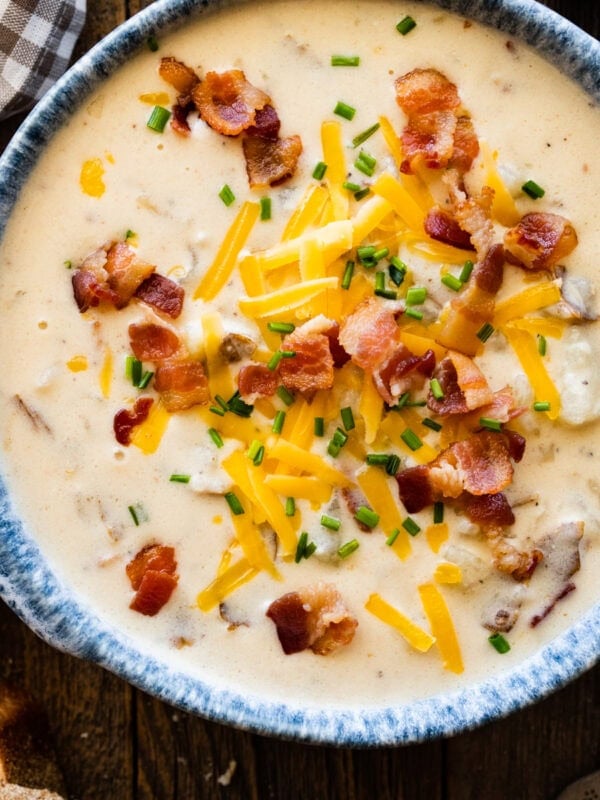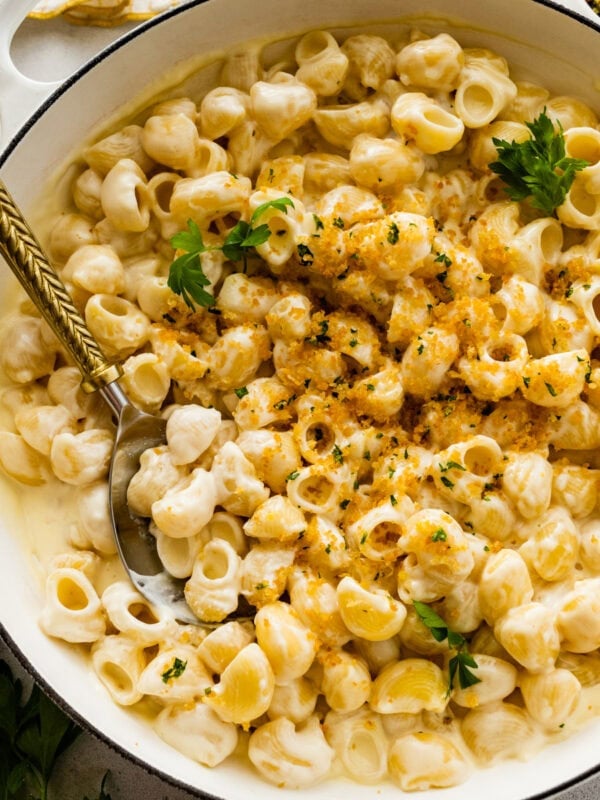Authentic Italian Pasta Alla Gricia Recipe
Sep 04, 2023, Updated Sep 14, 2023
This post may contain affiliate links. Please read our disclosure policy.
Authentic Italian Pasta Alla Gricia Recipe– Pasta alla Gricia is a classic Roman pasta dish from the Lazio region. It’s a simple yet delicious recipe highlighting guanciale, Pecorino Romano cheese, and black pepper. It is an easy 20-minute pasta dinner for a busy weeknight!
You’ll also love Classic Carbonara, Arrabiata, and Cacio e Pepe.

I have a lot of favorite pasta dishes, and this is at the top of my list!
This Pasta Alla Gricia recipe’s star is guanciale, cured jowl. If you don’t have it, use Pancetta or even bacon. It won’t be as authentic, but it will still taste amazing!
This recipe resembles a white Amatriciana Tomato Sauce.

Table of Contents
- Simple Ingredients
- How to Make Authentic Italian Pasta Alla Gricia Recipe Step-by-Step Photos
- Origins of Pasta Alla Gricia Recipe
- Substitutions for Guianciale
- How To Store and Reheat Leftovers
- Top Tips for Authentic Pasta Alla Gricia
- FAQs
- More Pasta Recipes
- What to Serve with Pasta Alla Gricia
- Authentic Italian Pasta Alla Gricia Recipe
Simple Ingredients
These ingredients combine to create a simple yet flavorful dish that highlights the rich, savory flavors of the guanciale and Pecorino Romano cheese, with the black pepper adding a touch of heat.

- Pasta: Choose a pasta variety that you prefer, such as spaghetti or rigatoni. Pasta is the base of the dish and provides a satisfying, comforting element.
- Guanciale: Guanciale is a traditional Italian cured meat made from pork cheek or pork jowl. It has a rich, fatty flavor and a slightly chewy texture. When cooked, it becomes crispy and adds a delicious savory taste.
- Pecorino Cheese: Pecorino Romano Cheese is a hard, salty cheese made from sheep’s milk. It has a distinct sharp flavor that intensifies as it matures. The cheese is finely grated and adds a tangy, salty taste to the pasta dish, enhancing its overall richness.
- Black Pepper: Freshly ground black pepper is a key ingredient in Pasta alla Gricia. It adds a pleasant, aromatic spiciness and complements the flavors of the guanciale and cheese. The amount of black pepper used can be adjusted to suit your preference.
- Salt: Salt is used to season the pasta water, bringing out the flavors of the pasta itself.
- Extra Virgin Olive Oil (optional): While not traditionally included in Pasta alla Gricia, some recipes may call for a small drizzle of extra virgin olive oil when cooking the guanciale. This adds a subtle fruity flavor and helps prevent the meat from sticking to the pan.
See recipe card for quantities.
How to Make Authentic Italian Pasta Alla Gricia Recipe Step-by-Step Photos

Heat a large skillet or frying pan on medium heat. Add the guanciale and cook it until it becomes crispy and golden brown. Stir occasionally to ensure even cooking. This process should take about 5-7 minutes.
While the guanciale is cooking, add the pasta to the boiling water and cook it until al dente according to the package instructions. Al dente means the pasta should still have a slight bite to it. Stir pasta occasionally.

For best results, make sure to grate youown cheese!

Once the guanciale is crispy, remove the skillet from the heat with a slotted spoon and set it aside. Be sure to keep the rendered fat in the pan as it adds flavor to the dish.
When the pasta is cooked, reserve a small cup of pasta water, then drain pasta.

Return the skillet with the guanciale to low heat. Add the drained pasta to the skillet, and toss it with the guanciale to coat the pasta evenly. If the mixture seems dry, you can add a splash of the reserved pasta water to moisten it slightly.

Sprinkle the grated Pecorino Romano cheese over the pasta and toss it well, allowing the cheese to melt and coat the pasta.

The heat of the pasta should be enough to melt the cheese, but if needed, you can put the skillet back on low heat briefly while stirring. The pasta water, fat, and cheese will create a naturally creamy cheese sauce.

Season the pasta with freshly ground black pepper to taste. Be generous with the pepper, as it adds a distinctive flavor to the dish.
Serve the Pasta alla Gricia immediately while it’s hot. You can sprinkle some additional Pecorino Romano cheese and black pepper on top for garnish, if desired.
Origins of Pasta Alla Gricia Recipe
Pasta alla Gricia is one of the most classic Roman pastas that originated in the region of Lazio, specifically in and around the city of Rome. It is a simple and delicious recipe highlighting cured pork and cheese flavors. Although its exact origin is unclear, Pasta alla Gricia is believed to have been created by the shepherds of the region who used the ingredients readily available to them.
Learn more about this recipe in this Roman recipe post!

Substitutions for Guianciale
If you don’t have guanciale available, there are a few substitutions you can consider in Pasta alla Gricia:
- Pancetta: Pancetta is a popular substitute for guanciale. It is an Italian cured pork belly that is often easier to find in grocery stores. It has a similar flavor profile to guanciale, with a rich and slightly salty taste. Cut the pancetta into small cubes or strips and cook it until crispy before adding it to the pasta.
- Bacon: Regular bacon can also be used as a substitute for guanciale. However, it’s important to note that bacon is usually smoked, which can add a different flavor to the dish. Look for bacon with a lower smoke intensity or opt for unsmoked bacon if possible. Cook the bacon until crispy and then crumble or chop it before mixing it with the pasta.
- Prosciutto: While not traditional, prosciutto can be used as a substitute in a pinch. It is a dry-cured Italian ham with a delicate flavor. Cut the prosciutto into thin strips or small pieces and cook it briefly until it just starts to crisp up. Be cautious with the saltiness, as prosciutto can be saltier than guanciale, so adjust the salt in the recipe accordingly.
Remember that the flavor and texture may vary slightly from the authentic Pasta alla Gricia when using these substitutions. However, they can still provide a delicious outcome and an enjoyable pasta dish!

How To Store and Reheat Leftovers
Store
- Transfer the pasta to an airtight container or sealable plastic bag. Make sure the container is suitable for storing food.
- Place the container in the refrigerator. Store in the fridge for up to 3-4 days.
Reheat
- Stovetop method:
- Add a small amount of water or broth to the pan to help rehydrate the pasta.
- Heat the pan over medium-low heat, and stir occasionally until the pasta is heated. Be careful not to overcook it, or it will get mushy.
- Once heated, remove from the heat and serve immediately.
- Microwave method:
- Place the desired portion of pasta in a microwave-safe dish.
- Sprinkle a few drops of water over the pasta to help retain moisture.
- Cover the dish with a microwave-safe lid or plastic wrap and leave a small vent for steam to escape.
- Microwave on medium power for 1-2 minutes, stir halfway through, until the pasta is thoroughly heated.
- Check for even heating and continue microwaving in short intervals if needed.
Top Tips for Authentic Pasta Alla Gricia
- Quality Ingredients: Since Pasta alla Gricia is a simple dish with few ingredients, it’s crucial to use high-quality ingredients. Opt for authentic guanciale, Pecorino Romano cheese, and freshly ground black pepper to ensure the best flavors.
- Cook the Guanciale Properly: Cook guanciale slowly over medium heat until it becomes crispy and golden brown. This process allows the fat to render, infusing the dish with rich flavors. Stir occasionally to ensure even cooking and prevent burning.
- Don’t Overcook the Pasta: Cook the pasta until it is al dente, meaning it should still have a slight bite. Overcooked pasta can become mushy and affect the texture of the dish. Follow the package instructions and taste the pasta a minute or two before the recommended cooking time to ensure it’s cooked to your desired consistency.
- Save Pasta Water: Reserve a small cup of starchy pasta water before draining the cooked pasta. The starchy pasta water can moisten the dish and create a silky sauce when mixed with the guanciale and cheese. Add the starchy water gradually as needed to achieve the desired consistency.
- Toss the Pasta with the Guanciale: Add it directly to the skillet with the cooked guanciale once the pasta is cooked and drained. Toss the pasta well with the guanciale to coat it evenly and infuse it with the rendered fat flavors.
- Melt the Cheese: When adding the grated Pecorino Romano cheese to the pasta, ensure the skillet is on low heat. The residual heat from the pasta and guanciale should be sufficient to melt the cheese. Stir the pasta continuously to create a creamy, cheesy sauce. Briefly return the skillet to low heat while stirring to melt the cheese completely.
- Season Generously: Don’t be shy with the black pepper! The distinct flavor of black pepper is a defining characteristic of Pasta alla Gricia. Add freshly ground black pepper to taste, and be generous to enhance the dish’s overall taste.
- Serve Immediately: Enjoy Pasta alla Gricia immediately while it’s hot and at its freshest.

FAQs
“Gricia” refers to a specific pasta dish and a particular style of sauce in Italian cuisine. The term “gricia” comes from the name of the town of Grisciano, located in the mountainous region of central Italy known as the Apennines. Grisciano is the birthplace of the cured pork jowl known as guanciale, a key ingredient in Pasta alla Gricia.
Pasta alla Gricia and Pasta Carbonara are both classic Italian pasta dishes with distinct differences. Pasta alla Gricia features guanciale, Pecorino Romano cheese, black pepper, and salt, tossed in rendered pork fat for a rich and salty flavor. It lacks eggs in its sauce. On the other hand, Pasta Carbonara includes guanciale or pancetta, Pecorino Romano or Parmigiano-Reggiano cheese, eggs, black pepper, and salt. The eggs create a creamy sauce when combined with the hot pasta. While both dishes have similar ingredients, Pasta Carbonara stands out with its creamy texture and the use of eggs, while Pasta alla Gricia emphasizes the flavors of cured pork and cheese without eggs.
Pasta alla Gricia features guanciale, Pecorino Romano cheese, black pepper, and pasta, creating a rich and savory flavor. In contrast, Pasta Cacio e Pepe emphasizes Pecorino Romano cheese, black pepper, and pasta without the addition of meat. That is the main difference!
Pecorino Romano cheese is a key ingredient in Pasta alla Gricia, contributing to its distinctive flavor. However, if you can’t find Pecorino Romano, you can use Parmigiano-Reggiano as a substitute. The taste will be slightly different, but it will still be delicious.
Pasta alla Gricia pairs well with short, tube-shaped pasta like rigatoni or long pasta like spaghetti. The pasta shape is a matter of personal preference, so you can use the one you prefer or have on hand. You will love this recipe rigatoni alla gricia, or spaghetti alla gricia!
More Pasta Recipes
Looking for other recipes? Try these:
What to Serve with Pasta Alla Gricia
These are my favorite dishes to serve with simple pasta recipe:
💙 MADE THIS RECIPE AND LOVED IT? 💙 Please leave a ⭐️STAR rating and COMMENT below- I love connecting with you! Tag me with your creations on Instagram and find me on Pinterest.
Print
Authentic Italian Pasta Alla Gricia Recipe
Description
Authentic Italian Pasta Alla Gricia Recipe– Pasta alla Gricia is a classic Roman pasta dish from the Lazio region. It’s a simple yet delicious recipe highlighting guanciale flavors (cured pork cheek), Pecorino Romano cheese, and black pepper. It is an easy 20-minute pasta dinner for a busy weeknight!
Ingredients
- 350 grams (12 ounces) of pasta (traditionally spaghetti or rigatoni)
- 200 grams of guanciale, cut into small strips or cubes
- 100 grams (3.5 ounces) of Pecorino Romano cheese, finely grated- more for serving
- Freshly ground black pepper, to taste
- Kosher Salt, for pasta water
- Extra virgin olive oil (optional)
Instructions
- Fill a large pot with water and bring it to a boil. Add salt to season the water, like seawater, once the water is boiling.
- Heat a large skillet or frying pan on medium heat. Add the guanciale and cook it until it becomes crispy and golden brown. Stir occasionally to ensure even cooking. This process should take about 5-7 minutes.
- While the guanciale is cooking, add the pasta to the boiling water and cook it until al dente according to the package instructions. Al dente means the pasta should still have a slight bite to it. Stir pasta occasionally.
- Once the guanciale is crispy, remove the skillet from the heat with a slotted spoon and set it aside. Be sure to keep the rendered fat in the pan as it adds flavor to the dish.
- When the pasta is cooked, reserve a small cup of pasta water, then drain pasta.
- Return the skillet with the guanciale to low heat. Add the drained pasta to the skillet, and toss it with the guanciale to coat the pasta evenly. If the mixture seems dry, you can add a splash of the reserved pasta water to moisten it slightly.
- Sprinkle the grated Pecorino Romano cheese over the pasta and toss it well, allowing the cheese to melt and coat the pasta. The heat of the pasta should be enough to melt the cheese, but if needed, you can put the skillet back on low heat briefly while stirring. The pasta water, fat, and cheese will create a naturally creamy cheese sauce.
- Season the pasta with freshly ground black pepper to taste. Be generous with the pepper, as it adds a distinctive flavor to the dish.
- Serve the Pasta alla Gricia immediately while it’s hot. You can sprinkle some additional Pecorino Romano cheese and black pepper on top for garnish, if desired.
Enjoy your authentic Italian Pasta alla Gricia!
Notes
-
- Quality Ingredients: Since Pasta alla Gricia is a simple dish with few ingredients, it’s crucial to use high-quality ingredients. Opt for authentic guanciale, Pecorino Romano cheese, and freshly ground black pepper to ensure the best flavors.
-
- Cook the Guanciale Properly: Cook guanciale slowly over medium heat until it becomes crispy and golden brown. This process allows the fat to render, infusing the dish with rich flavors. Stir occasionally to ensure even cooking and prevent burning.
-
- Don’t Overcook the Pasta: Cook the pasta until it is al dente, meaning it should still have a slight bite. Overcooked pasta can become mushy and affect the texture of the dish. Follow the package instructions and taste the pasta a minute or two before the recommended cooking time to ensure it’s cooked to your desired consistency.
-
- Save Pasta Water: Reserve a small cup of starchy pasta water before draining the cooked pasta. The starchy pasta water can moisten the dish and create a silky sauce when mixed with the guanciale and cheese. Add the starchy water gradually as needed to achieve the desired consistency.
-
- Toss the Pasta with the Guanciale: Add it directly to the skillet with the cooked guanciale once the pasta is cooked and drained. Toss the pasta well with the guanciale to coat it evenly and infuse it with the rendered fat flavors.
-
- Melt the Cheese: When adding the grated Pecorino Romano cheese to the pasta, ensure the skillet is on low heat. The residual heat from the pasta and guanciale should be sufficient to melt the cheese. Stir the pasta continuously to create a creamy, cheesy sauce. Briefly return the skillet to low heat while stirring to melt the cheese completely.
-
- Season Generously: Don’t be shy with the black pepper! The distinct flavor of black pepper is a defining characteristic of Pasta alla Gricia. Add freshly ground black pepper to taste, and be generous to enhance the dish’s overall taste.
-
- Serve Immediately: Enjoy Pasta alla Gricia immediately while it’s hot and at its freshest.
















This was SO good. Great for a weekend meal as it’s super quick and easy with minimal prep and ingredients, but tastes elevated. Served it with an arugula salad and will absolutely be making again!
Yes, it’s super easy and comforting. I’m happy you loved it!
For a simple and quick recipe, it is loaded with flavor. I enjoyed each and every mouthful. This will be in my routine going forward.
Thank you
Happy you loved this simple dish!
Such a great recipe!
My family enjoyed this!!👌🏼😍
Yay! It is a good one. Happy they love it.